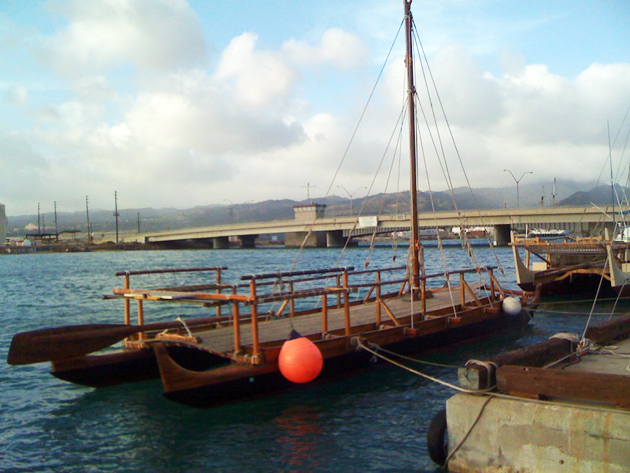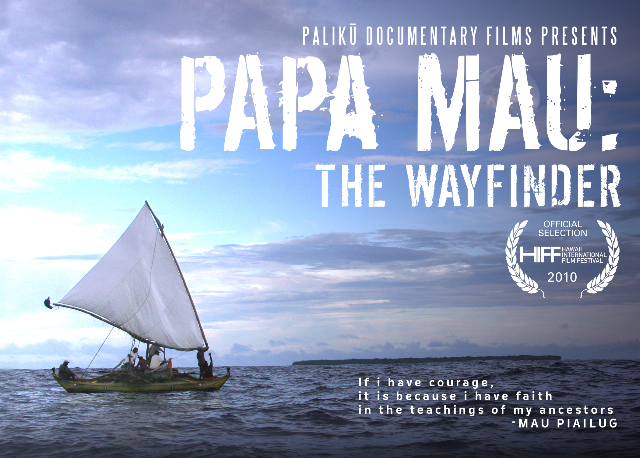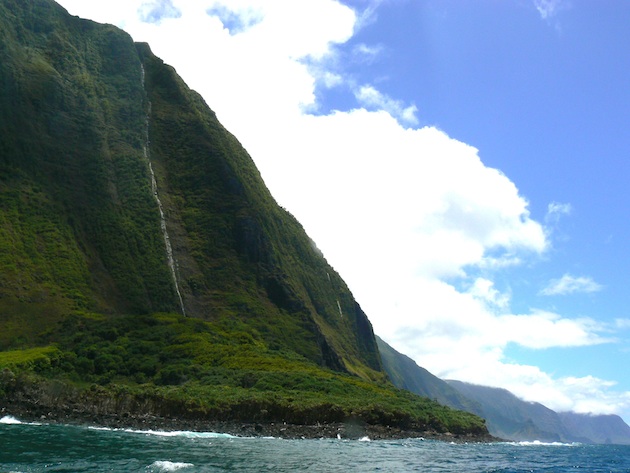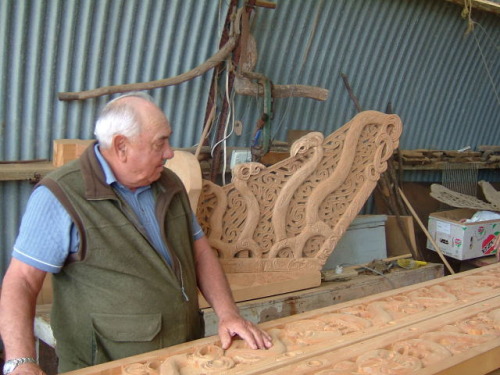Polynesian Voyaging Society: 2010 Events and News
Postings
- Dec. 17-19: School of Navigation in Honor of Mau Piailug
- Dec. 4: World Wide Voyage Educator Orientation
- Oct. 8: New Resources on Hawaiian Voyaging Traditions
- Sept. 23: Mālama Hōkūle‘a / Taking Care of Hōkūle‘a
- Sept. 10: Mapping the World Wide Voyage
- July 27: The World Remembers Mau ...
- July 24-August 28: Statewide Sail for Mau
- July 12: Mau's Passing
- February-June: Training Sails for the Worldwide Voyage
- June: Hector Busby's New Canoe (Aotearoa)
- June 12: Passing of Leon Sterling and Joanne Kahanamoku Sterling
December: School of Navigation in Honor of Mau Piailug
In preparation for the Worldwide Voyage, Nainoa Thompson took a group of navigators-in-training and educators for wayfinding lessons at sunrise in the Kaiwi Channel, outside of Kawaihoa Point, on Dec.17-19. The students began learning to identify and determine the direction of swells based on the position of the rising sun, a fundamental skill in non-instrument navigation.
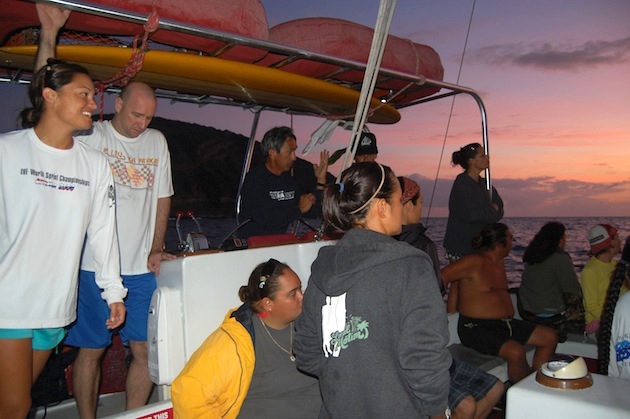
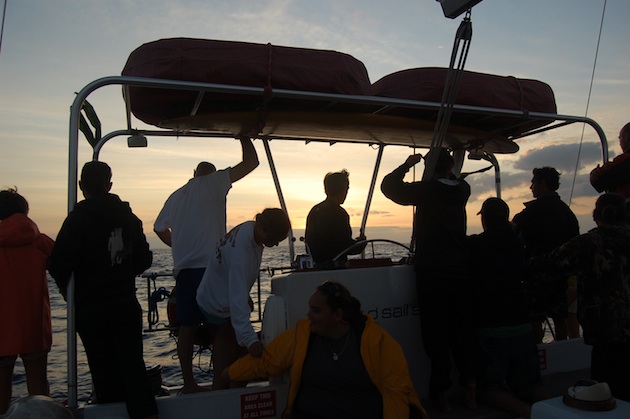
Named in honor of Satawalese master navigator Mau Piailug, the PVS navigation school will establish learning sites at the places in and around Maunalua Bay where Hawaiian pwo navigator Nainoa learned non-instrument wayfinding from Mau.

Mau passed away earlier this year, on July 12. In 1976, he successfully navigated Hōkūle‘a without instruments 2500 miles from Hawai‘i to Tahiti. In 1978, after Hōkūle‘a capsized in heavy seas south of Moloka‘i and crew member Eddie Aikau was lost after he paddled off on a surfboard for help, Mau agreed to return to Hawai‘i to teach his methods of wayfinding and voyaging to Nainoa and other Hawaiians.
The following places where Mau taught Nainoa are designated as learning sites of the navigation school:
Kaiwi Channel between O‘ahu and Moloka‘i: at sea, at sunrise, Mau taught Nainoa to read swells and determine their directions from the direction of the rising sun.
Kawaihoa, the Headland on the East Side of Maunalua Bay: At sea, south of this headland, Mau and Nainoa studied the shape of swells as they changed with the changing direction of the tides and currents that run along the south shore of O‘ahu.
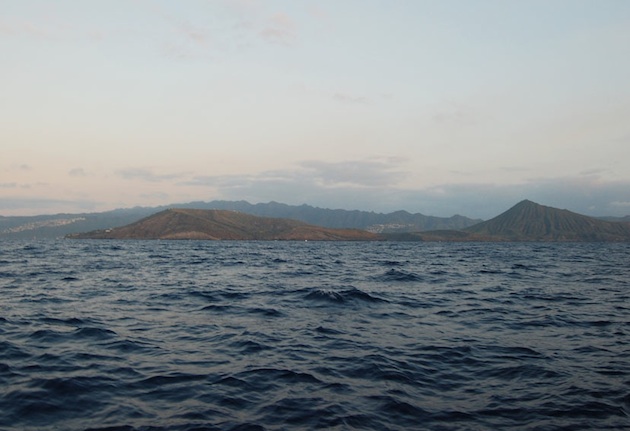
Kaiwi channel at dawn, south of Kawaihoa (left-center) and Koko Crater (right).
Kūlepeamoa Ridge, which runs down the middle of Niu Valley, dividing the valley in two smaller valleys: On O‘ahu, Mau lived with Nainoa’s family in Niu Valley and taught Nainoa about the stars from a site on this ridge.

Kūlepeamoa Ridge Divides Niu Valley into two smaller valleys.
Kuli‘ou‘ou Beach Park, at the end of Bay Street: Mau and Nainoa laid out a temporary star compass at this park, located on the coast at the mouth of Kuli‘ou‘ou, the valley to the east of Niu.
Lāna‘i Lookout: Located at the base of Koko Crater, on the southwestern side, Lāna‘i Lookout was a place where Mau and Nainoa studied clues to the day’s weather at sunrise, noting the colors of the sky, the kinds of clouds at the horizon, and the presence or absence of “smoke” (sea spray) in the atmosphere. At night, the site is ideal for studying stars in the southern sky, the ridge of Kawaihoa blocking Honolulu's lights.
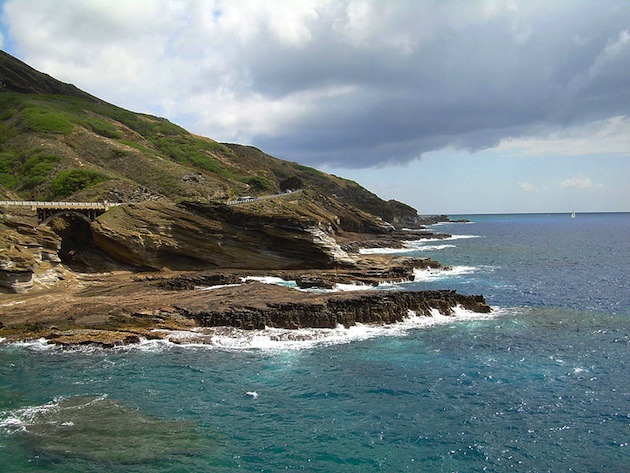
Lāna‘i Lookout (Photo from Wikipedia Commons).
Makapu‘u: This headland at the east tip of O‘ahu overlooks the Kaiwi channel. Mau and Nainoa had a birdʻs eye view of the pattern of swells on the ocean surface below.
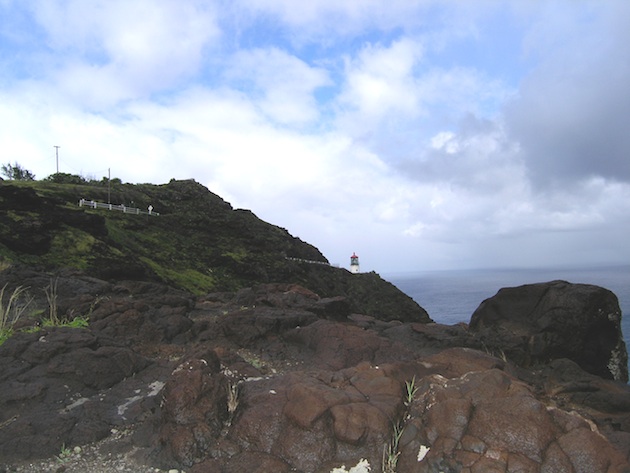
US Coast Guard Lighthouse at Makapu‘u
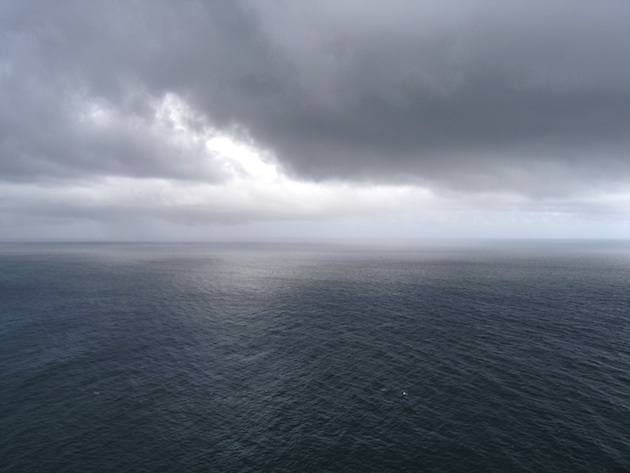
Pattern of Swells Observed from Makapu‘u Lighthouse
Mānana, north of Makapu‘u: This island is a seabird sanctuary and serves as a nesting place for sooty terns, brown noddies, wedge-tailed shearwaters, bulwers petrels, and red-tailed tropic birds. Here Mau and Nainoa studied seabirds, knowledge of which is essential to landfinding.

Mānana lsland beyond Kāohikaipu Island, from Makapu‘u Point.
Other places on O‘ahu will be used as training sites in the navigation school:
- Maunalua Bay and Hanauma Bay: to study reefs.
- Mokumanu in Kāne‘ohe Bay: to study seabirds.
- Ka‘ena and Kū‘īlioloa Heiau (W), Kahuku (N), Natatorium (S), Makapu‘u and Kualoa (E): to study stars in the four cardinal directions.
- Hakipu‘u-Kualoa: Birthplace of Hōkūle‘a
- Marine Education Training Center, Honolulu Community College: for classroom teaching and learning.
- Bishop Museum Planetarium: to study the stars.
Mau also taught Nainoa that navigation was not just about sailing. The navigator is responsible for caring for his people and the land and sea they depend on for their well-being. As part of its special kuleana (responsibility), PVS is training the navigators and crew of Hōkūle‘a to assist with projects like the restoration of Maunalua Bay, in particular the offshore reefs, working with Mālama Maunalua, a community-based organization aimed at preserving and restoring the health of the Maunalua region.
On Dec. 18, Kewalo Basin Lab scientist and University of Hawai‘i professor Bob Richmond presented the crew with information on coral reef ecology and after explaining what to look for in assessing the health of the reefs, snorkeled with the crew at two reef sites in Maunalua Bay.
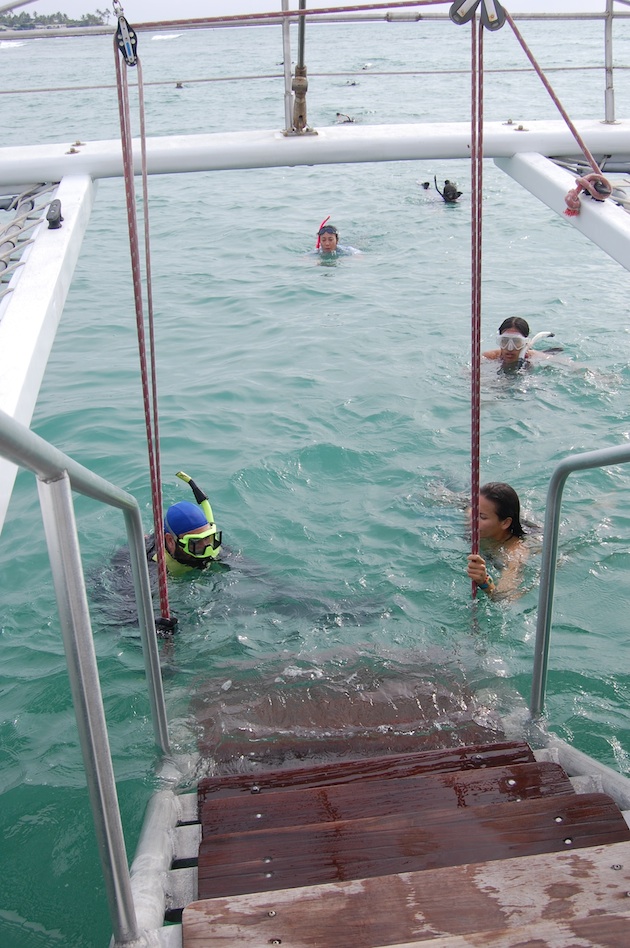
Bob leads a group of snorkelers back to Noa Noa, a catamaran donated to PVS to support its mission of education.
Bob also demonstrated a probe that can be lowered into the bay to measure salinity, turbidity, ph, and other physical qualities of the water at various depths.
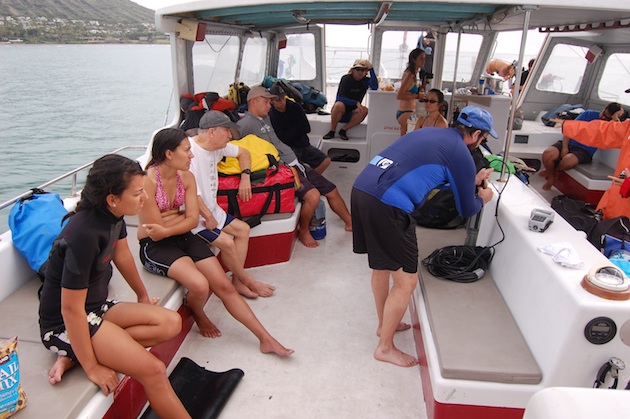
Bob prepping the seawater probe to demonstrate its use.
Bob shared an article he co-authored on Maunalua Bay reef ecology and restoration efforts with PVS: "Quantifying the impact of watershed urbanization on a coral reef: Maunalua Bay, Hawaii."
He has also been involved in coral reef management in Palau, Guam, and Pohnpei. See "Watersheds and Coral Reefs: Conservation Science, Policy, and Implementation."
The escort boat crew caught some ‘ū‘ū, which the catamaran crew scaled and cleaned for dinner that night.
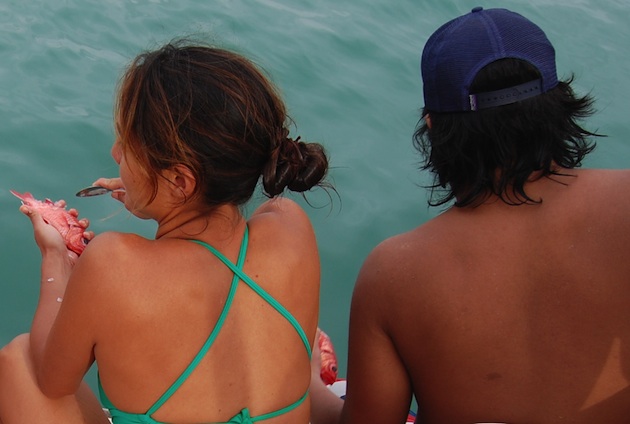
December: World Wide Voyage Teacher Orientation (Photos by Kapulani Landgraf)
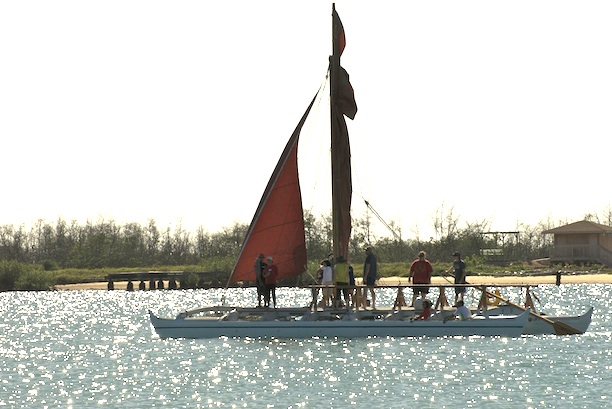
Kamauheheu Sailing in Ke‘ehi Lagoon
The Polynesian Voyaging Society (PVS) is establishing a Teacher Orientation Program at Honolulu Community College’s Marine Education and Training Center to support teachers in the development of a vision-based curriculum to motivate student learning and success in Hawaiʻi schools.
The vision for the curriculum is the PVS vision and the vision for the Worldwide Voyage: Mālama Hawaiʻi, Mālama Honua, Taking care of Hawai‘i, Taking care of the Earth.
The courses and classes PVS wants to see developed in schools in Hawai‘i and around the world would incorporate the features of PVSʻs successful crew training program – vision-based, project-based, place-based, community-based, and culture-based. (See Key Elements of Education.)
The first workshop for the PVS teaching training initative took place on Dec. 4, 2010, at METC. Nainoa Thompson spoke to a group of 35 administrators and faculty of Kapi‘olani Commnity College about the upcoming World Wide Voyage and his hope that it would transform education in Hawaiʻi.

Navigator Nainoa Thompson spoke to a the educators about the vision and mission of Hōkūle‘a’s Worldwide Voyage and the need for quality education based on compassion, kindness and caring for each other and planet Earth in order to create a sustainable future for our children. The following is an edited 30-minute version of Nainoa's talk (video by Kelsey Matsu).
KCC Teachers Talk with Nainoa Thompson from Jenna Ishii on Vimeo.
Participants had the opportunity to sail on Kamauheheu, Honolulu Community College's coastal sailing canoe. This activity was designed to illustrate how a practical, hands-on application like sailing can be the basis for cultural and scientific learning and for learning about values like teamwork, cooperation, and taking care of each other.
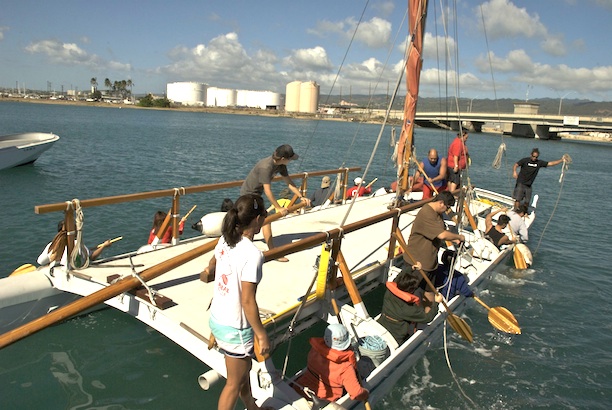
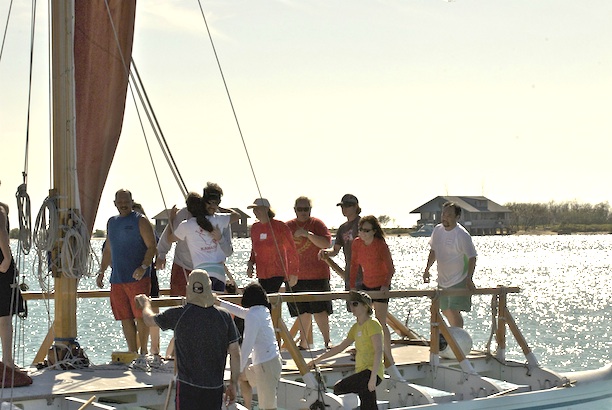
The participants also had an opportunity to paddle out to Mokauea Island, about a hundred yards offshore from METC, to visit its fishing village and fishpond. Kai Makana, which is working on various cultural and envrionmental restoration projects on the island, invites teachers and students to engage in service-learning. This activity was designed to provide an example of how a place could become a community site for educational activity involving cultural and scientific learning and taking care of the land and cultural resources of islands.
In fall 2011, Kapi‘olani Commnity College will launch a first year experience program for freshmen, incorporating in its classes the PVS vision and the features of the PVS crew training program.
October: Three New Resources on Hawaiian Voyaging Traditions
- Papa Mau: The Wayfinder, a film on Mau Piailug and the revival traditional navigation in Polynesia by Naʻalehu Anthony/Palikū Documentary Films premieres at the Hawai‘i International Film Festival (HIFF) on Saturday, October 16, 2010 at 5 PM at Dole Cannery Theaters; also playing on Saturday, October 23 at 11:30 AM. Tickets at HIFF website.
- The Hawaiian language version of Never Lost: Polynesian Navigation, a multimedia website, is now available at http://www.exploratorium.edu/neverlost/ . (The website is a project of San Francisco’s Exploratorium, and its partners the ʻAha Pūnana Leo Inc. Mahele Honuakai, Exploration Sciences Division; the University of Hawaiʻi at Hilo, ʻImiloa Astronomy Center of Hawaiʻi; and Ka ʻOhana Waʻa Pākīpika, The Pacific Voyaging Family.)
- Ka’ilila’au’s Canoe – A Journey of Spirit, an hour-long TV program produced by Emme, Inc. about a Maui canoe built by Ka’anapali Beach Hotel employees, premieres on Thanksgiving, November 25, 2010 from 7-8pm on KGMB and rebroadcasts on Saturday, November 27, 2010 from 6-7pm. For more information about the film, see "Crew of canoe to fulfill pledge to family that donated wood" (Maui News).
September: Mālama Hōkūle‘a/Taking Care of Hōkūle‘a
In preparation for the upcoming statewide sail (2012) and World Wide Voyage (2013-2017), Hōkūle‘a came out of the water last week and is on land at the Marine Education and Training Center (METC) for a projected year-long drydock.

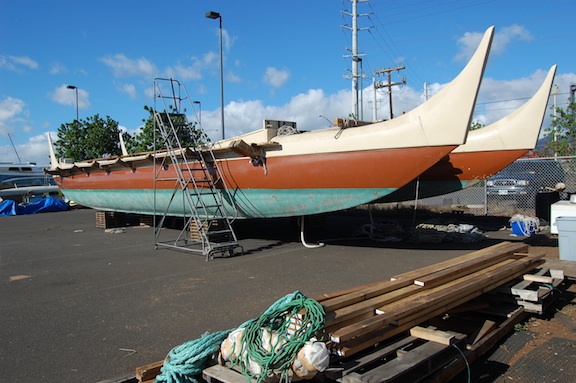
Hōkūle‘a at METC, 2010
Mālama Waʻa coordinator Bruce Blankenfeld said that the decking inside the hulls above the storage compartments have dry rot and will be replaced; the pola (open deck over the ʻiako, or crossbeams) will be widened by two feet to increase the living and working space; and the inside gunnels will be heightened to project above the open deck to prevent water from splashing up into the sleeping compartments.

Drawing (1995) by Star-Bulletin artist David Swann
The canoe will be unlashed and taken apart, so that other parts can be refinished or replaced. The canoe will be relashed with new cordage.
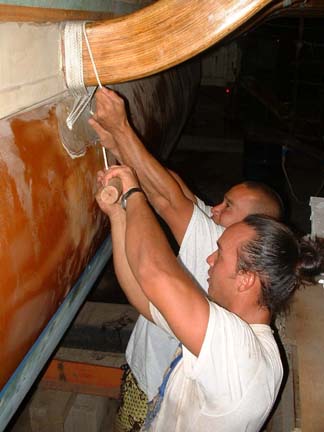
Russell and Kawai Lashing Hōkūleʻa (2002)
September: Mapping the World Wide Voyage (Link to a Separate Webpage)
July: The World Remembers Mau ... (Link to a separate Webpage)
- Kaselehlie Press (Pohnpei), July 26: Legendary Master Navigator Pius “Mau” Piailug sails on
- News Release, Government of the Federated States of Micronesia, July 23: Master Navigator "Mau" Piailug Dies on July 12, 2010
- The Economist, July 22: Pius Mau Piailug, master navigator, died on July 12th, aged 78
- Washington Post, July 21: Micronesian who sailed by navigating sun and stars
- Saipan Tribune, July 19: Sons of Mau Piailug talk about the master navigator
- The New York Times, July 17: Star Man
- The Wall Street Journal, July 15: Pacific navigator kept sailing techniques afloat
- Tahiti Presse, July 15: Hōkūle‘a navigator Mau Piailug
- The Star Advertiser, July 13: Voyager guided rebirth of culture
Biography on Wikipedia: "Mau Piailug"
July-August: Statewide Sail for Mau
On July 24, Hokule'a departed on a statewide sail in honor of the late master navigator Mau Piailug. Her first stop was Kaua'i, where she stayed until August 3. The journey continued with her return to O'ahu, from where she left for Moloka'i on August 5, with plans to travel on to the Big Island, to Hilo (arrival on Aug. 10), Kawaihae/Pu'ukohola (Aug. 14), Kona (Aug. 18), Honaunau (Aug. 20), and Kawaihae (Aug 21); then on to Maui (Aug. 28).
On the Big Island, Hokule'a will be joined by two sister canoes, Hokualaka'i at Hilo and the Makali'i at Kawaihae. The three canoes will sail in unity back to Kualoa, Hakipu'u, He'eia in Kane'ohe Bay on O'ahu, by August 29.
At Kualoa, members from the ‘Ohana Wa‘a will gather with native peoples from around the world as part of the the “Healing our Spirit Worldwide” conference. Hokule'a will return to its home at METC, Sand Island, on September 6.
During the statewide sail, crews will continue to train for the upcoming World Wide Voyage, scheduled for departure in May 2012, in keeping with Mau's request that his students keep sailing in order to continue to teach and perpetuate his tradition of navigation.
On July 24, a sunrise service for Mau was held at Lana'i Lookout, on the southeast coast of O'ahu, to reflect, remember and aloha Papa Mau. Nainoa Thompson, Bruce Blankenfeld, Billly Richards, John Kruse & Makanani Attwood shared their special memories and times with Mau. Lana'i Lookout was a teaching site for Mau when he was on O'ahu, because it was a good place for observing and learning how to read weather, ocean swells, and stars.

Lana'i Lookout (from Wikimedia Commons)
July: Ua ho'i akula ke kumu makua makamae o ka 'au wa'a / The treasured Master of the fleet has returned to the sea.
It is with great sadness I share the news of the passing of Master Navigator Mau Piailug at his home on the shores of Satawal.

For the many of you that have directly benefited from Mau's unselfish sharing and generous spirit I ask that you keep his memory alive as an example of the difference that one incredible individual can make to the betterment of society and communities that value a life of friendship.
To my fellow Pwo Navigators and Senior members of the Voyaging Community, remember Mau's challenge to us to be stewards of the Art and to the communities we serve.
Me ke mana'o 'i'o,
na Kalepa
See "Piailug's greatest lesson is that we are a single people" by Chad Kalepa Baybayan.
June: Teachers Training Sail (Photos by Karen Holman)
Throughout 2010, PVS has been conducting crew and leadership training for the upcoming World Wide Voyage. Crew reports on the Training Sails are posted at the World Wide Voyage Blog.
The training sail from June 11-16, from METC at Sand Island, O'ahu, to Lana'i, Kaho'olawe, Maui, and Molokai'i, was designed for teachers to explore how the voyaging experience can inspire and motivate learning and to help them develop curriculum based on the voyaging model that is project-based, culture-based, place-based, and community-based.
Click on map for larger image.
Starry Nights
Star observations are best on clear nights in dark places, without ambient light from urban areas.
The best night on this training sail was at Kaumalapau Harbor, Lana'i, where Hokule'a docked on the afternoon of June 11. The sky was clear, and just after sunset, at 7:35 or so, Hanaiakamalama, the Southern Cross appeared upright above the horizon, due south. To the left of it, rising above SSE were the two bright pointers, Kamailemua and Kamailehope (Alpha and Beta Centauri).
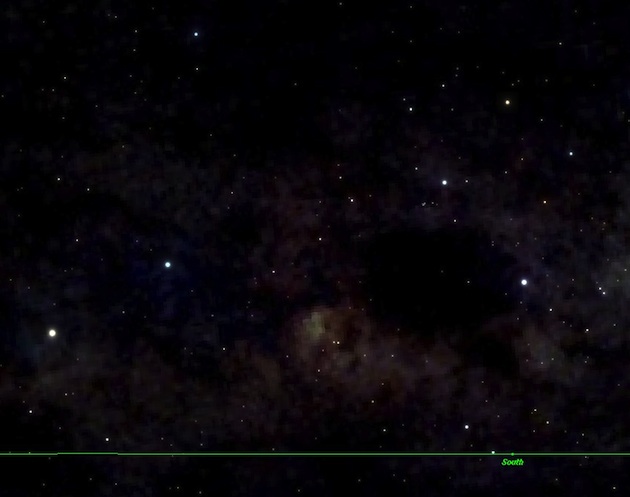
Nainoa wanted the teachers to observe this configuration of Hanaiakamalama, in which Ka Mole Honua (Acrux, the bottom star of the cross) is six degrees above the horizon and Kaulia (Gacrux, the top star) is six degrees above Ka Mole Honua. In addition to being a directional inidicator pointing south, this configuration is used to determine when voyagers from the South Pacific have arrived at the latitude of Hawai’i. After they sail up to the windward side of the islands and observe this configuration, they turn west to search downwind for islands.
Voyages home are timed so that this configuration is available to the navigator. As summer passes, Hanaiakamalama crosses the meridian earlier and earlier, until it is upright during daylight and can’t be seen. June was the last time it could be seen until the early morning hours of January.
Rising to the left of the pointers and the cross, above SE, was Ka Makau Nui o Maui ("The Big Fishhook of Maui," called Scorpio in the west).
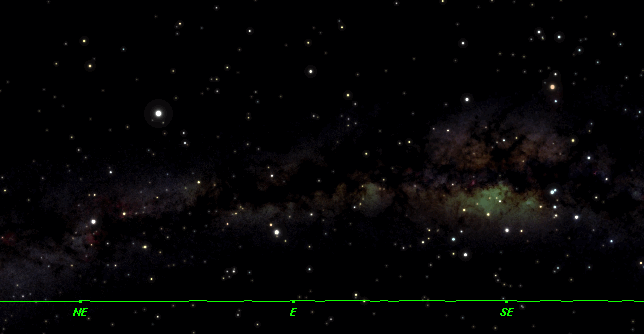
The Milky Way is called I‘a (Fish) in Hawai‘i or I‘a-lele-i-aka (“Fish leaping in shadows”). In Aotearoa, the Milky Way is known as Te Māngōroa (The Long Shark), Ika-roa (Long Fish), or Te ika Māui (The Fish of Māui) (Edward Robert Tregear, The Maori Race 402). In Rarotonga, The Milky Way is said to be the spirit of Moko-roa (long water-monster) (Beckwith Hawaiian Mythology 439).
The Fishhook of Maui looks like it is embedded in the mouth of the jaws of a giant celestial fish formed by two bright patches of the Milky Way. The body of the fish stretches across the horizon to the NE.
In between the head and tail of the fish is the Navigator’s Triangle, with Keoe (Vega) on the back of Ka I’a (between E and NE); Pira’etea (Deneb) embedded toward the tail (above NE); and Humu (Altair) just under the belly, above E.
As Ka I'a rises above the eastern horizon, it looks as if Maui's fishhook is pulling it through the sky. The tail of the fish is marked by the W-shape of Iwakeli'i (Cassiopeia) rising at NNE.
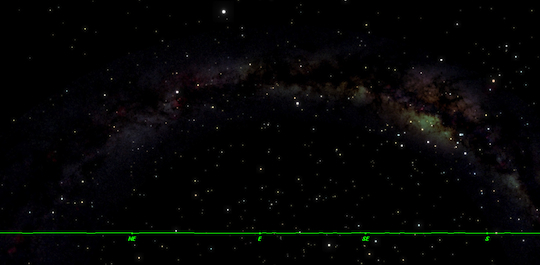
Around midnight, Ka I'a crosses the meridian overhead. Toward dawn, it appears upside down, above the western horizon:
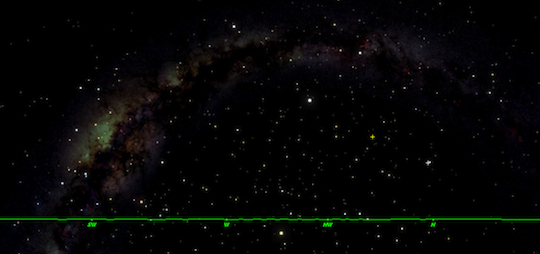
This passage of Ka I'a through the early summer sky is described by the phrase "Ua huli ka Iʻa," "the Milky Way has turned [changed position; it is past midnight]" (Pukui-Elbert Dictionary).
It was clearly visible at Kaumalapau, the night of June 11.
Storied Places
The teachers visited historical and legendary sites to consider ways to develop place-based social and cultural studies curriculum.
After a night at Kaumalapau, Hokule'a departed for Honokanai'a, "Bay of the Dolphins," on Kaho'olawe. A pod of nai'a, or dophins, greeted the crew.
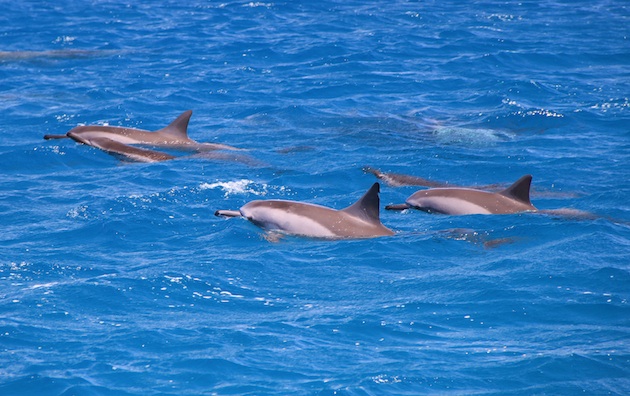
The crew visited Kealaikahiki ("The Way to Kahiki"), on the west tip of Kaho'olawe, where master navigator Mau Piailug came to dedicate a platform of coral for observing stars and learning navigation.

After stopping for a night in Lahaiana, the crew sail down the north coast of Moloka'i, a land of story and history. Two places associated with the story of Ku'ula-kai and his son 'Ai'ai, two fishing gods, are Wailau and the Pali of Kahiwa:
Wailau: "When 'Ai'ai landed at Wailau, he saw both sides of the valley covered with men, women, and children damming the stream and diverting its water to another course where they could scoop up the 'o'opu and 'opae. The water being low, the gourds of some of the people were full from their catch. 'Ai'ai noticed their wanton method of fishing, whereby all the 'o'opu and 'opae were caught without any thought of conservation for their propagation, so he called on his parents to take all the fish away. The prayer was granted, for suddenly all the 'o'opu and 'opae disappeared."
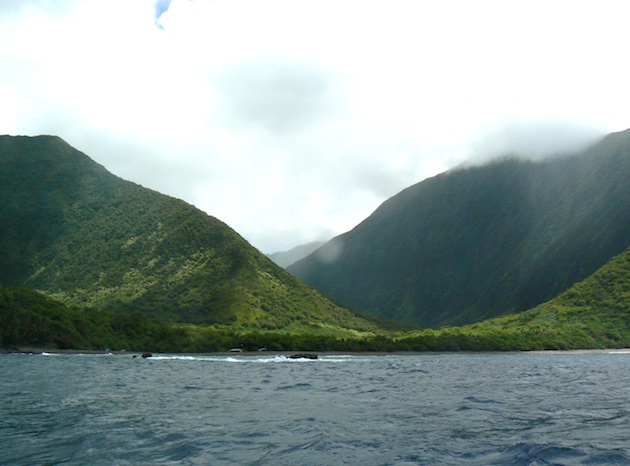
The Pali of Kahiwa (east of Wailau): "The people [of Wailau] were much surprised … and sorely disappointed at the loss of their food supply. Because of his regard for a certain local lad named Kahiwa, 'Ai'ai revealed to him the place of the 'opae up the steep cliff of Koki. The youth followed 'Ai'ai’s directions and found the 'o'opu and 'opae where they are still found today. This incident established the noted saying of the old people of that land: 'Koki-o-Wailau is the ladder of the 'opae.' The cliff is also known as the Pali of Kahiwa."
Anapuhi (Eel-cave): This sea cave with two openings, just west of Haupu Bay, was the site of a battle between a mano (shark) and a puhi (eel) who lived in the cave. The mano had killed and eaten his two younger siblings and was made an outcast. He tried to take refuge in Anapuhi, but the eel, who was the guardian of the coast from Pelekunu to Halawa, fought and killed the shark. The battle was so fierce, the second opening was created. Since that time the sharks of the coast have been forbidden to take human life.
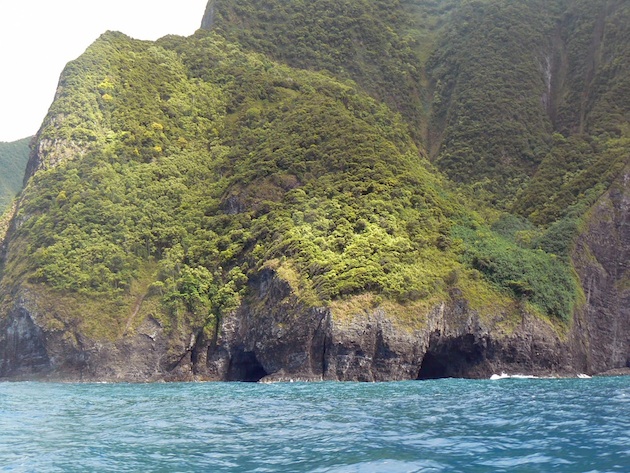
Kalawao and Kalaupapa: These two lands tell the story of Hansen's disease in Hawai'i, the Leper Colony, and Father Damien.
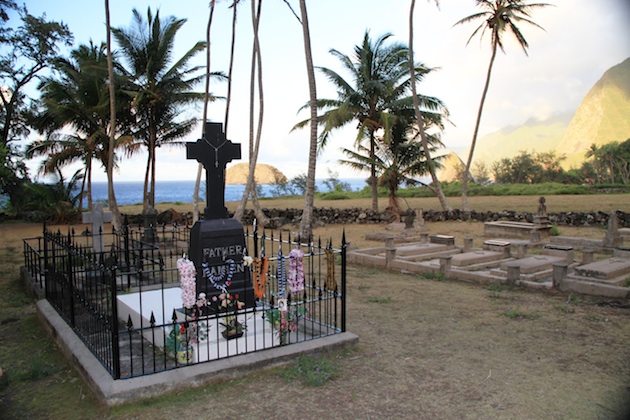
Observing Reefs
The teachers also dove at spots along the north coast of Moloka'i to examine the condition of the reefs and reflect on ways to develop reef environmental curriculum and projects.

Service Learning
The teachers engaged in service projects in order to learn about places, contribute to the health of the community, and consider how service learning can be integrated into their courses.
At Honokanai'a, the crew planted 'ilima and 'ohai on an embankment protecting an ahu (altar) overlooking the bay. Makanani Attwood, who was working on the ahu, said the site would be used for a ceremony marking the 20th anniversary of the stopping of the US military bombing of the island, to be held in October. The 'ilima and 'ohai were chosen for their ability to survive in a dry place, with little rainfall.
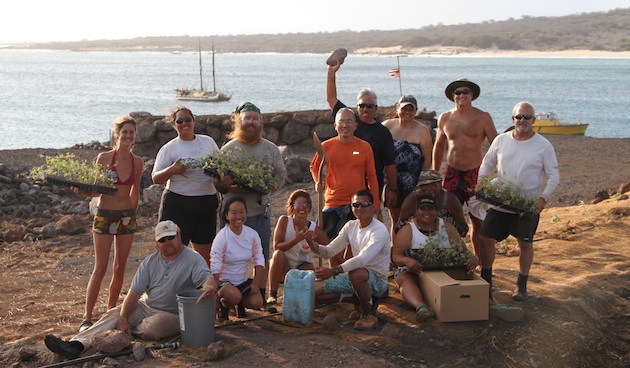
At Lahaina, on Maui, the crew stayed at the canoe halau where Mo'okiha, a new double-hulled canoe was being built; the crew assisted by sanding the hulls.

Photo of Mo‘okiha from Hui o Wa‘a Kaulua Facebook Page
At Kalaupapa, on Molokai'i, the crew participated in weeding and cleaning the plant nursery while learning about efforts to restore native plants in the National Park.
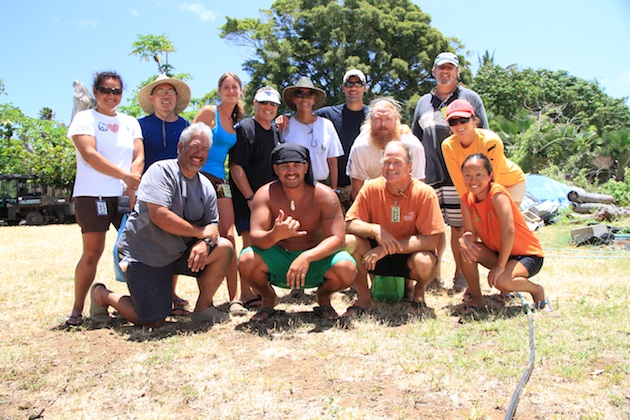
Throughout 2010, PVS has conducted training sails for the World Wide Voyage. Crew member reports are posted at the World Wide Voyage blog:
- Posted Oct. 7: Hōkūleʻa Reflection: Six-day Training Sail, June 2010 (Maui Tauotaha)
- Posted June 30: Six-day Teacher Training Voyage, June 2010 (Linda Furuto)
- Posted March 16: Overnight Training Sail with Captain Ka‘au McKenney, March 6 (Tina Daehler-Masifilo)
- Posted March 1: Overnight Training Sail, Jan. 16 (Karen Holman)
- Posted February 25: Hōkūleʻa Overnight Training Sail, Feb. 16 (Matt Limtiaco)
- Posted February 23: Overnight Training Sail with Captain Bruce Blankenfeld (Photos by Sam Low)
- Posted February 17: Crew Training - 8 Day Deep Sea Voyage (Captain Mike Taylor)
June: Launching of Master Waka Builder Hector Busby's New Canoe (News from Aotearoa)
A new canoe by Master Waka Builder Hector Busby will be officially launched on Saturday 26 June 2010 at Aurere, Bay of Islands at 11 am where its name will be announced as part of the waka launching ceremony.
A haka specially composed for Leiden by Kaumatua Waka Historian Tepene Mamaku will also be featured as part of the launch.
Sea trials will be conducted by Kaihoe who have been selected by Robert Gabel, Chair of Nga Waka Federation.
The ceremonial waka will be on permanent loan to Volkenkunde Museum in Leiden, Netherlands, and will remain as a working exhibition. Njord Royal Rowing Club based in Leiden will work alongside Volkenkunde Museum staff to maintain the ceremonial waka while it is in their care.
The official handover of the Ceremonial waka to Volkenkunde Museum will occur on the 18 October 2010 amidst an elaborate ceremony.
Toi Maori Aotearoa, who sponsored the building and launching, is the national organisation for Maori art and artists and receives major funding from Te Waka Toi, the Maori Arts Board of Creative New Zealand.
June: Passing of PVS crew members Leon Sterling and Joanne Kahanamoku Sterling. Posted by Chad Kālepa Baybayan
Mai ka ulu koa o uka a i ka ulu koa o kai
Ua kani ka papa waʻa i ka hoʻi o ke aloha
E kūnou nā kia me he niu moe
No Paoa lāua ʻo Kahanamoku
From the upland koa forest, to the koa forest on the sea
The core of the canoe has sounded at the departure of the loved ones
Let the masts bow as the laid over niu tree
In honor of Paoa and Kahanamoku
(A kanikau, chant of mourning composed by Kaimana Barcarse.)
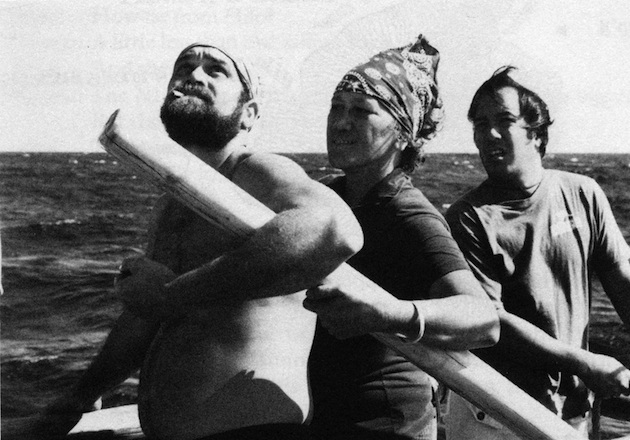
Leon Sterling, Joanne Kahanamoku-Sterling, and Harry Ho. Photo from Will Kyselka's An Ocean in Mind.
It is with a sad and heavy heart that I share the news of the passing of our dear and beloved friends, Joanne Kahanamoku and Leon Sterling. As we all struggle to deal with the huge loss of two truly significant individuals who contributed and devoted much of their lives to the cause of voyaging and the community that supports it, much of the conversation I have had with members of the 'Ohana Wa'a and its extended family has focused on how inexplicable the simultaneous passing of Leon and Joanne on Maui and the Big Island yesterday morning has been. It has left many of us with a strong sense that a greater power has been involved in this departure and although very painful, many of you have expressed a sense of appropriateness in the manner in which their passing unfolded.
Jo was a powerful woman who always dominated all the conversations I had with her, she was never short on opinion, and never deplete of love for the canoe and its family. Leon was the best sailor we had as long as we could keep him on the canoe. He stood tall and bald, and was always dressed on hot days in those baggy light blue speedos’s (you guys know which one I mean). He supported David and Gordon well as their First Mate, and in 1986, led us as captain through the most severe weather I have been in, between the Kermadecs and Tongatapu. In 1980, I sailed with Leon and Jo off of Hamakua where seven of us almost lost our lives. But most of all and many of you already know this, they introduced me to Hōkūle'a, got me aboard, trained me, and stood by me when I was a clumsy beginner, felt awkward in new situations, and searched hard to find myself. They connected me to my passion and I owe them my profession and my undying love.
Keep them in your prayers and please in lieu of flowers, send your memories.
May: E Ala Homecoming
The Wai‘anae Wa‘a Kaulua E Ala, launched in 1981 at Poka‘i Bay to revive the arts of canoe-building and voyaging on the Wai‘anae Coast, returned home for 2 weeks in April.

E Ala, Hokuleʻa and Kama Uheheu have sailed along the Waiʻanae Coast and stayed in Pokaʻi Bay for canoe tours and education outreach sails. On Day 1 of the sail, family members greeted crew members in Makua for a nighttime potluck on the beach. On Day 2, 800 students from Kawaihona Charter School welcomed the crew members at Nanakuli Beach, and on Day 3, family and community members welcomed all three canoes for a beautiful arrival ceremony at Pokaʻi Bay.
Every day last week was dedicated to bringing elementary school students to tour E Ala and learn about navigation and provisioning for a deep sea voyage. Principals and teachers from the Waiʻanae Coast were invited to sail on E Ala and Kama to connect them with the spirit of voyaging as they prepare to bring such values into their schools and classrooms.
Students of Waiʻanae and Nanakuli High School along with Kamaile Academy helped to give canoe tours to school groups all week. The Waiʻanae and Nankuli community members embraced the canoes and the crew members every day with food and support until this past Saturday when all three canoes sailed back to the Marine Education Training Center safely. Mahalo Nui for all of the support from the Waiʻanae Coast community!
The three canoes were captained by Kaina Holomalia, Waimea McKeague, and Sam Kapoi, all three of whom grew up on the Wai‘anae Coast.

The drydock of E Ala to prepare her for her voyage home took place at HCC's Marine Education Training Center under the leadership of Kaina Holomalia and Sam Kapoi, with veteran navigator Bruce Blankenfeld.
